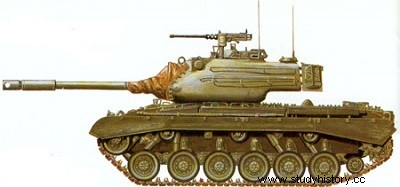
M48, M48C, M48A1, M48A2, M48A2C, M48A3, M48A4, M48A5, M67, M67A1, M67A2, M48 AVLB
Type: medium tank.
Crew: 4 men.
Armament: a 90 mm M41 gun; a coaxial .30 M1919A4E1 machine gun (some vehicles mount a 7.62mm MG M73); a .50 in the command cupola.
Armour:
minimum 12.7 mm;
maximum 120mm.
Dimensions:
length (including main armament) :7.442 m;
length (hull): 6.882m;
width: 3.631 m;
height (dome included):3.124 m.
Weight in combat order: 47.1 t.
Ground pressure:0.83 kg/cm2.
Engine: Continental AVDS-1790-2A 12 cyl. air-cooled diesel, developing 750 hp at 2,400 rpm.
Performance:
road speed: 48 km/h;
range: 463km;
vertical obstacle: 0.915 m;
clean cut: 2.59 m;
slope: 60%.
Service time: introduced in 1953 in the US Army. Employed by Germany, South Korea, Spain, USA, Greece, Israel, Jordan, Morocco, Norway, Pakistan, Taiwan, Thailand, Turkey and Vietnam.
Once authorized the production of the M47 began the study of a new medium tank because the M47 was only a transition machine. In October 1950, therefore, Detroit Arsenal began the study of a new medium tank armed with a 90 mm gun.
The design was completed two months later and in December 1950 Chrysler received a contract to improve it and produce six prototypes under the designation T48. The first of these prototypes was to be ready in December 1951.
In March, when the prototypes were not even finished, Ford and the Fisher Body division of General Motors obtained the order for the T48 which would of course become the M48. Production began in 1952 and the first deliveries to the US Army took place the following year.
The M48 was also manufactured by Alco Products, of Schenectady, New York, and production finally closed at Chrysler's Delaware plant in 1960. The M48 gave way on the assembly lines to the M60, basically an M48A3 but armed with a 105 mm cannon and perfected in other respects. Production of this model was undertaken at the Detroit Tank Factory.
The hull of the M48 is a cast assembly, as is the turret. The driving position is at the front of the hull, the three other members of the crew are housed in the turret, the tank commander and the gunner on the right side, the loader on the left side.
The engine and transmission are located at the rear of the hull, separated from the combat chamber by a firewall. The torsion bar suspension consists of six road wheels, a sprocket at the rear and a tension wheel at the front. Depending on the model, the support rollers are three, four or five in number and some models mount a small tension pulley between the sixth road wheel and the sprocket.
The main armament - consists of a 90 mm cannon which points in elevation from -9° to +20° and in azimuth over 360°. A .30 M1919A4E1 machine gun is mounted in the axis of the main armament, although most M48s in service with the American army are equipped with a 7.62mm M73 as well (except the M48A1). The cupola can cover 360° in azimuth and the machine gun points in elevation from -10° to +60°. Ammunition load depends on the model; it is for the M48A3 62-round 90mm, 6,000-round .30, and 630-round .50.
If needed, the M48 can accommodate a bulldozer blade attached to the front of the hull. All models have infrared headlights, some mount an IR/white light projector above the main armament. The type can ford up to 1.20 m without preparation or 2.45 m using a buoyancy kit.
The components of the M48 are found in the M88 recovery tank and the M53/M55 self-propelled (the M55 is no longer in service). The basic M48 mounted a single external machine gun command cupola. The second model, the M48C, with its mild steel hull, could only be used for training.
The M48A1 was followed by the M48A2 with many improvements including an injection system for the engine and larger capacity tanks. The M48A2C was a slightly modified M48A2. On the other hand, the M48A3 represents significant progress thanks to its diesel engine which considerably increases its operational autonomy, also thanks to many other modifications, in particular a new fire control.
The M48A4 was to take over the turret of the M60 when this last tank would have been re-equipped with a new turret mounting the 152 mm "Shillelagh" missile system but this project was abandoned so that the M48A4 was never put into service. The newest model is the M48A5, basically an M48A1 or M48A2 with a newly designed 105mm, new tracks, 7.62mm M600 coaxial and similar machine gun on the loader hatch, plus many other minor modifications.
More than 1,200 M48A5s are being converted and deliveries have already begun to the National Guard (the new models will not be fielded by the US Army) .
Three flamethrower versions were developed:the M67 (on M48A1 chassis), the M67A1 (on M48A2 chassis) and the M67A2 (on M48A3 chassis). These devices were used by the Marines in Vietnam but none are more operational today.
On the other hand, an M48 AVLB is in service:it carries a scissor bridge which can ensure the crossing of excavations reaching the width of 18.30 m. Over the years, the M48 has seen many experimental versions.
The IDF has fitted many of its M48s with a 105mm gun and a low profile cupola. The U.S. military picked up the idea and realizes it today.
Korea, the United States, Pakistan and Vietnam have used the M48 in combat. Maneuvered well, the tank is quite capable of throwing down the gauntlet to Russian machines such as the T-54 and T-55; the M48A5 with the 105 mm gun should do well in front of a Soviet T-62.
The Pakistanis lost nearly 100 M48s in a single battle in the 1965 war with India, but this debacle was largely due to poor tactics. Two years later, the Israeli M48s achieved great success during the Six-Day War.
